
How to Tell If Your Cumin Has Gone Bad
Get Your Free Food Safety Cheat Sheet
30 most common foods with instant answers. Print it and stick it on your fridge—completely free!
How to Tell If Your Cumin Has Gone Bad
Cumin is a popular spice known for its warm, earthy flavor and aromatic properties. Whether you use it to add depth to curries, stews, or even as a seasoning for meats and vegetables, cumin is a staple in many kitchens. However, like all spices, cumin can go bad over time, losing its flavor and potency. In this guide, we will explore how to tell if your cumin has gone bad and provide you with practical tips on storing it properly to maximize its shelf life. (Cumin)
Signs of Spoiled Cumin
1. Loss of Aroma
- Fresh cumin should have a strong, aromatic scent. If your cumin has lost its fragrance or smells musty, it may have gone bad.
2. Change in Color
- Cumin seeds are typically brown in color. If you notice any discoloration, such as dark spots or a faded appearance, it could indicate spoilage.
3. Taste Test
- If you are unsure whether your cumin has gone bad, conduct a taste test. Spoiled cumin will have a stale or bitter flavor.
4. Presence of Mold or Pests
- Inspect your cumin for any signs of mold growth or the presence of insects or pests. If you notice any of these, it is best to discard the cumin.
Proper Storage of Cumin
To ensure the longevity and freshness of your cumin, proper storage is key. Follow these tips to keep your cumin flavorful for longer:
1. Store in a Cool, Dark Place
- Keep your cumin in an airtight container and store it in a cool, dark place away from heat and sunlight. Exposure to light and heat can accelerate the spice's deterioration.
2. Avoid Moisture
- Moisture can cause cumin to clump together and promote the growth of mold. Make sure the container is tightly sealed to prevent moisture from entering.
3. Use Glass or Metal Containers
- Opt for glass or metal containers to store your cumin. These materials are less porous than plastic and can help maintain the spice's freshness.
4. Label and Date
- Properly label your cumin container with the date of purchase or the date you opened the spice. This will help you keep track of its freshness.
5. Avoid Storing Near Heat Sources
- Keep your cumin away from heat sources such as the stove, oven, or dishwasher. Heat can cause the spice to lose its flavor more quickly.
Conclusion
In conclusion, cumin is a versatile spice that can enhance the flavor of your dishes. By knowing how to identify if your cumin has gone bad and following proper storage practices, you can ensure that your cumin remains fresh and flavorful for longer. Remember to trust your senses when assessing the quality of your cumin and always prioritize food safety when handling spices. With these tips in mind, you can continue to enjoy the rich and aromatic taste of cumin in your culinary creations. (Cumin)
Authoritative Food Safety References
These agencies and university labs inform every tip and health precaution we publish.
USDA FoodKeeper – Cold Storage Guidelines
Official refrigerator, freezer, and pantry timelines maintained by the U.S. Department of Agriculture.
Visit USDA FoodKeeperFDA Produce Safety Rule & Grower Guidance
Field-to-fridge handling practices that prevent contamination of fruits, vegetables, and leafy greens.
Visit FDA Produce SafetyCDC Foodborne Illness Prevention Hub
Surveillance-backed guidance on pathogens, symptoms, and steps to reduce foodborne illness risk.
Visit CDC Food SafetyUC Davis Postharvest Technology Center
University research detailing optimal storage atmospheres for produce after harvest.
Visit UC Davis PostharvestPenn State Extension – Home Food Preservation & Safety
Peer-reviewed extension bulletins on safe canning, chilling, and reheating practices.
Visit Penn State ExtensionGet Your Free Food Safety Cheat Sheet
30 most common foods with instant answers. Print it and stick it on your fridge—completely free! Want more? Upgrade to the complete guide with 70+ foods.
Scan your food directly and get instant safety info using our AI-powered camera feature.